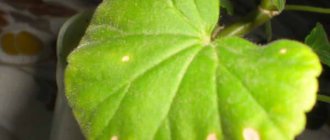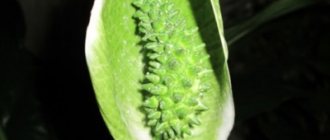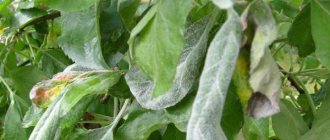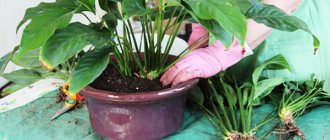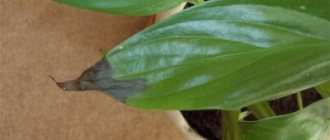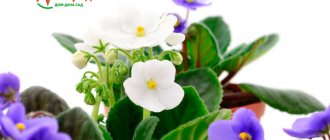What most often affects the plant?
- Lack of growth - excessive soil moisture or excess sun rays.
- Brown spots on the foliage are a sign of pest damage or excessive moisture. Lack or abundance of moisture leads to the appearance of black tips.
- Blackness on the surface of the leaf blade means a low content of nitrogen, phosphorus, and potassium.
- Dry tips on a young plant indicate that it is adapting to new conditions.
- If a formed bush suffers , change watering, making it frequent.
- Lack of flowering - transplantation into an overly large pot occurred, which led to the growth of the root system, instead of throwing out flower stalks.
If the transplant was not carried out, and there are still no buds, you need to place the pot on the balcony for 2 weeks and maintain the temperature at least 12-13 degrees. - Curling leaves are a sign of a cold room. The optimal temperature for this family is +18…+24 degrees.
- Loss of flower brightness and wilting is often associated with root rot.
Major pests
The main enemies that cause spathiphyllum diseases that need treatment are: mealybug, aphid, spider mite, scale insect, sooty fungus.
- Mealybug is a common pest that often causes spathiphyllum disease. Basically, it originates in conditions of increased dampness, hiding between the leaves. For preventive purposes, you should periodically inspect the flower. If the number of insects is minimal, it is easy to get rid of them by removing them with a rag soaked in an alcohol solution. Actellik or insecticides will help with global infection; an infusion of citrus peels is also effective.
- Sooty fungus can form on the upper side of leaves. Its occurrence is often indicated by blackening of the spathiphyllum. The disease must definitely be eliminated, as it interferes with the processes of photosynthesis and respiration of the plant, causing it to weaken. The best treatment for sooty fungus is to treat the affected surface with soapy water.
- The scale insect (shield aphid) at a young age is barely visible; its appearance is signaled by dark spots covering the leaves and stems of spathiphyllum. The disease is effectively treated by spraying the flower with a soap-tobacco solution mixed with a small amount of denatured alcohol or kerosene. Aphids mainly concentrate on the lower part of the leaves and use spathiphyllum juice for nutrition. Without proper treatment, the disease leads to curling and drying of the leaves of the flower. Gray, green and black aphids are found and spread instantly. Treatment of the plant consists of treating it with nicotine sulfate (1 gram per liter of water).
- And finally, the greatest threat to spathiphyllum is the spider mite. The pest mainly occurs on foliage, covering it with cobwebs. Its spread leads to the gradual drying out of the plant. Treatment involves removing the cobwebs and treating the flower with a soap solution. In advanced cases, more effective means may be needed: ground sulfur, insecticides.
The best way to prevent spathiphyllum from being damaged by pests is to frequently wipe the leaves of the plant with a sponge and water. It is recommended to “bathe” the flower only when the soil is covered with a film.
When and what should be treated, how to do it?
Urgent resuscitation is done when previous efforts have not produced a positive effect and the pet’s condition is worsening every day.
Black leaves, delayed flowering, a dark-colored root system, withered crown of young shoots, stunted growth - these are clear signs of a dying bush. How to cure a plant?
The rescue goes like this::
- The spathiphyllum is removed from the pot and the rotten roots are cut off.
- Intact roots are washed with potassium permanganate. After this, they are treated with activated carbon and wrapped in newspaper for a day.
- While they are drying, a container with new soil is prepared. The soil is poured into the pot after drainage holes are made and a drainage layer is laid.
- Next, the flower is transplanted into new soil.
- Immediately after transplantation, watering is not performed. The top of the spathiphyllum is covered with plastic film or a plastic bottle, creating a greenhouse effect.
What does a flower of female happiness look like, photo
As a rule, flowers grow with large lanceolate or oval leaves with raised veins.
The beginning of the flowering of “female happiness” is impossible not to notice. From time to time, inflorescences-cobs appear from the rosette, which are covered by one large “spread”-shaped petal. Most often it comes in a white shade.
We are talking about a perennial evergreen plant. This genus includes dozens of species, which are divided into several sections. Well, the following varieties are very popular among amateur gardeners:
- “Profusely blooming”: blooms for a long time, produces many buds;
- “Lovely” : it is characterized by large (up to 10 cm in width and 25 in length) leaves with not white, but greenish petals;
- “Picasso” : with an unusual color of sheets (ranging from creamy white, light green, to dark green, brown);
- "Domino" : with variegated leaves, in which symmetrical alternation of light and dark veins occurs more often than in "Picasso";
- “Sensation” : is one of the largest indoor varieties, because can reach a height of 1.5 m.
Useful video
‘]
How to prevent the problem from happening again?
- Carry out regular inspection of the flower.
- Fertilize with Fitoverm.
- Do not use a sprayer with large openings.
- Maintain optimal room temperature.
- Spray with water in winter and autumn to combat dry air masses.
- Water as the soil dries out.
- Feed with complex fertilizers once every 30-45 days.
Spathiphyllum does not often suffer from illnesses . His illnesses in most cases are the result of improper care. If you notice the blackening of the leaves in time and identify the cause of this condition, the plant can be saved.
Causes of blackening of flowers
Spathiphyllum flowers are very attractive, and abundant flowering makes this indoor plant very decorative. Spathiphyllum has a very high level of sensitivity to waterlogging of the soil, and if this happens, the cores turn black and the flowers darken.
Insufficient soil moisture when growing “female happiness” (as spathiphyllum is often called) is also very difficult for the plant to tolerate and negatively affects the appearance of the flowers. The plant needs almost constant and regular spraying of the leaves, but moisture should not be allowed to get inside the flowers themselves.
Why do the tips of the leaves of the flower of female happiness dry out, what to do
Why do the tips of the leaves of the flower of female happiness dry out, what should I do?
Causes
There is no need to look for problems in violation of care and similar issues if you did everything according to the rules. It's simple, because... the flower lives its own life and regulates some processes itself. For example, removing everything old and unnecessary, preparing for flowering, etc.
Here are the main points to consider when trying to understand what is happening to the plant.
- If the ends of the leaves at the base of the flower dry out, this may indicate the death of old large leaves. This is the norm. The flower saves its strength. But if the situation is the same with new leaves, then look for the reasons and take action.
- And when the ends dry out and turn yellow, you can think about aging. Those. The plant's strength is running out, and this is how it gives a signal for help.
What to do if the leaves of “female happiness” suddenly dry out?
Each process has its own starting point. Those. you missed some point (watering, fertilizing, replanting, etc.), and “women’s happiness” began to turn yellow. The leaves are actually turning yellow.
What to do if the leaves of “female happiness” suddenly dry out?
So, we need to clarify the reason that affected the condition of the plant. This can be either its location, watering regime, deficiency or excess of fertilizers, indoor heat, or burns from direct sunlight.
This guest from the tropics loves moisture and it is natural that its leaves dry out and then darken.
- The first thing you can try is a light warm shower or sprinkling.
- Try to remember when you fertilized. The plant may begin to wither without receiving its dose of minerals. So, resume this process. Or cancel fertilizers if you realize that there are a lot of them (especially mineral ones).
- Adjust the watering mode. And, after removing excess moisture from the pan, loosen the soil.
- You can remove the flower from a hot place or from a windowsill where the plant receives direct sunlight.
- Trimming old leaves and a thorough examination of the entire flower also helps in such situations.
You should know it
The main thing is to notice the problem in time and eliminate it according to all the rules.
Useful video
Spider mite
Spider mites are not difficult to distinguish. They usually settle on the underside of the leaf, and also weave a small web.
The leaves of spathiphyllum (any plant) begin to dry out, as pests literally draw out the life sap of the flower.
For treatment, you can prepare a concentrated soap solution, rinse the leaves well, remove ticks and cobwebs (several times); if the lesion is severe, you will need to buy a special preparation and treat it according to the instructions.
Watering a flower - female happiness
The fragile plant, it turns out, is not particularly whimsical. But some conditions cannot be avoided. Proper watering of the flower of female happiness is one of them.
But flooding it is like death. After all, in this case the root system dies. Here are some secrets that will help you.
Secret 1 . Determine the need for watering by examining the top layer of soil - if it is dry, it needs to be moistened.
Secret 2. Water the plant only with settled, soft and slightly acidic water. Otherwise the hard one will cause big problems.
Secret 3. The temperature of the water for irrigation should not be lower than room temperature.
Secret 4 . Try to water at the same time every day.
Remember
Both deficiency and excess of moisture are detrimental to “women’s happiness.”
Useful video
The flower of female happiness does not bloom, how to feed it
If you regularly water your green friend, treat it on time and get rid of all evil spirits, but do not feed it, you are unlikely to get any return from it. The flower of female happiness is not blooming, what should I feed it with?
As for feeding spathiphyllum, you need to purchase a special fertilizer for flowering plants (or replace it with a universal fertilizer).
Among the specialized products with a full range of macro- and microelements in the composition (in particular nitrogen, sulfur, magnesium, iron, phosphorus, copper and others) the following should be mentioned:
- fertilizers in tablet format;
- preparations for flowering plants;
- liquid preparations to activate flowering.
The main thing is to do this regularly. By fertilizing your pet once a week, and in winter - once every two to three weeks, you will have a huge impact.
By the way, in addition to organic (mullein with water or biological fertilizers Biud or Raduga, mineral fertilizers - Kemira) and others, you can also use home remedies such as sugar, coffee grounds, tea, banana peels, etc.
Useful video
Late blight
Late blight affects garden, garden, and indoor plants. Its causative agents are lower fungi (division oomycetes), leading a parasitic lifestyle. Their place of residence is the soil; they penetrate all parts of different types of plants, from grasses to trees.
The external manifestations of the disease are very variable; they are often considered a consequence of violation of the conditions of indoor culture. Fungi infect all organs of the flower and are active at every phase of its life. The main symptom of late blight is dry rot, in contrast to processes caused by bacteria and other fungi. Phytophthora cactorum spores fall on the shoots and leaves of a home flower, form a mycelium, and quickly develop in comfortable conditions. The plant gets sick, dries out, and dies.
Signs of a fungal infection:
- the appearance of brown spots on the leaves;
- their growth and darkening;
- softening of stems and leaf blades;
- deformation and rotting of parts of the flower.
Even if late blight occurs on the above-ground part of the plant, the spores quickly penetrate the root system. They can enter the apartment not only with air when ventilating the room, but also through the soil. In contaminated soil, the spores remain viable for several years, so all prepared soil must be sterilized (calcined in the oven) before planting, and the pots must be doused with boiling water.
An infected plant cannot be treated and cannot be saved. Spathiphyllum along with the soil must be destroyed immediately. It's easier to grow a new flower than to try to save a sick one.
Caring for spathiphyllum at home
Rules of care
Watering during the growing season and flowering should be plentiful, but the roots of spathiphyllum do not tolerate stagnant moisture, so maintain moderation and let the top layer of the substrate dry between waterings. In winter, watering is reduced, but the substrate should not dry out completely. Spathiphyllum requires high air humidity, so in spring and summer it is useful to spray the plant frequently or simply wipe the leaves with a damp sponge, and in winter it is better to keep the flowerpot on a tray with wet pebbles or expanded clay. The resting period of spathiphyllum lasts from October to January.
Soil for spathiphyllum
The substrate for spathiphyllum needs to be loose and fertile. In its natural habitat, spathiphyllum grows in soil consisting of fallen leaves, compost, charcoal and rotting branches, so you can make a soil mixture for home spathiphyllum from three parts peat, two parts garden soil, two parts perlite and three parts orchid substrate , which in turn consists of charcoal, bark and gravel.
You can try a different composition, the main thing is that the soil for spathiphyllum is not heavy, otherwise there is a risk of water stagnation in the roots. To avoid root rotting, take care of good drainage.
Transfer
Young plants are replanted every year, so it is important to know how to properly replant spathiphyllum. Plants that have reached five years of age are transplanted only when roots appear from the drainage hole. Spathiphyllum needs a small and shallow pot; in large pots the soil turns sour even before the roots of the plant have mastered it. Each time, choose a container that is not much larger than the previous one, and as soon as you reach a pot with a diameter of 18-20 cm, you can stop replanting, just update the top layer of substrate in the flowerpot from time to time. This recommendation applies only to those spathiphyllums that grow no higher than 30-40 cm.
Before removing the spathiphyllum from the old pot, water it well. If you are interested in spathiphyllum growing large, with beautiful leaves, when replanting, separate all the lateral shoots, on which the plant spends considerable energy. Pour a drainage layer of expanded clay 2-2.5 cm thick into a new pot, then a few centimeters of fresh substrate, on which place the spathiphyllum along with a lump of earth, and gradually add the substrate into the voids, compacting it as the pot is filled. If the new soil is wet, water it only lightly after replanting the spathiphyllum so that the soil settles. In the evening, when it gets dark, spray the plant with a solution of two drops of epin in a glass of water to speed up the rooting process. The procedure can be repeated after a week.
- Hydrangea at home: care and propagation
After transplantation, do not water the spathiphyllum for the next few days, but spray it twice a day to make it easier for it to recover from stress. Watering is resumed three to four days after transplantation.
Reproduction of spathiphyllum
Spathiphyllum propagates by dividing the bush during spring replanting. The lateral shoots along with the roots are carefully separated from the mother plant, trying not to damage them, then the divisions are planted in separate containers with a substrate for an adult spathiphyllum and cared for, as described in the previous chapter.
As for the propagation of spathiphyllum by seeds, even if you manage to collect them, their germination rate, which is already low, is lost very quickly, so you need to sow the seeds immediately after collecting them in soil made of sand and peat, cover them with glass or film and make sure that so that the soil in the greenhouse is moist but not wet, ventilating the seedlings from time to time. The seed method of propagation is complex and time-consuming; in addition, there is no guarantee that as a result you will get the variety that you sowed, so amateur flower growers prefer the vegetative method of propagating spathiphyllum.
Fertilizer
Spathiphyllum is fed once every 2-3 weeks during the growing season from March to September with complete mineral fertilizer at the rate of 1-1.5 g per 1 liter of water. You can alternate mineral and organic fertilizers. During the dormant period, feeding is stopped, but if the plant continues to grow, then you can fertilize it once a month.

